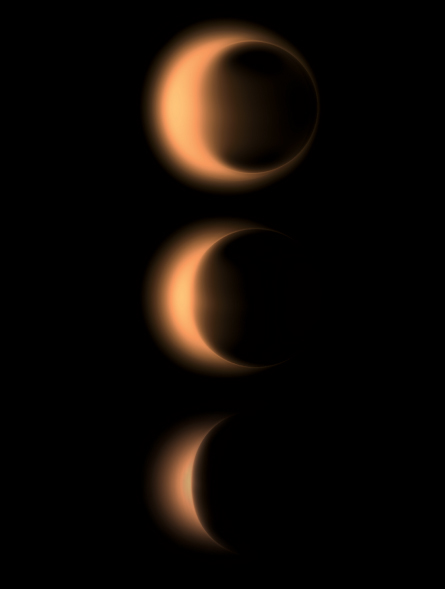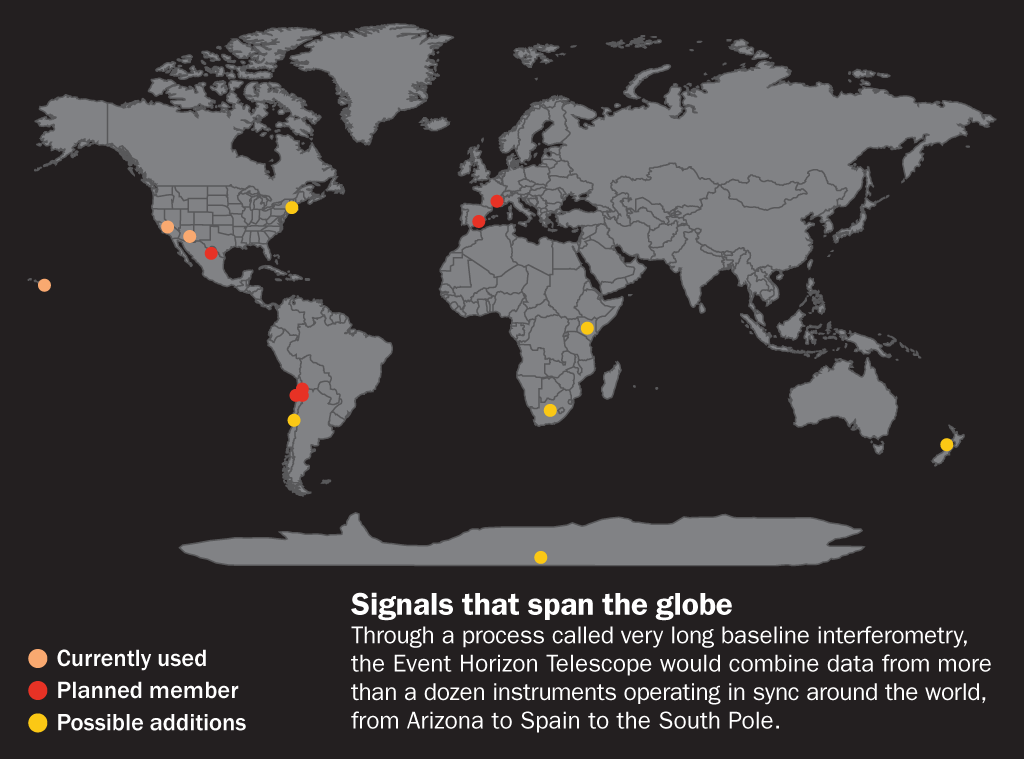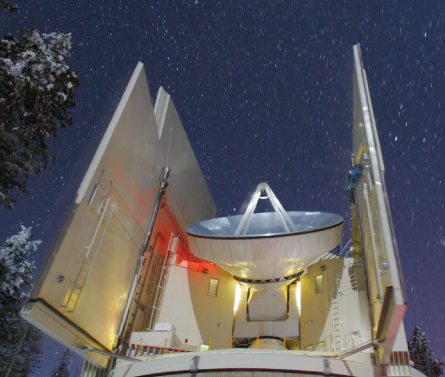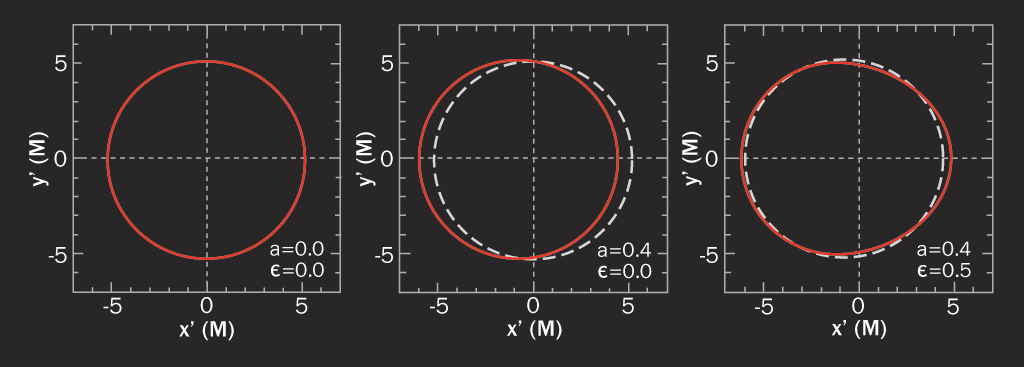- More than 2 years ago
Black holes are among the most bashful yet flamboyant characters on the cosmic stage. They consume matter so voraciously that the violence can ignite brilliant beacons called quasars, bright enough to outshine entire galaxies. Yet because they prevent light from escaping or even bouncing off, black holes themselves are also the ultimate unseeables.





Astronomers have now drawn up plans to gather an image of something almost as good: a black hole’s silhouette. They will do it with a virtual telescope spanning the globe, electronically roping together scores of smaller instruments at observatories that usually operate independently. The new array’s magnifying power will exceed that of any telescope or array made so far. Two targets await: the monster black hole believed to reside at the center of the Milky Way, home galaxy to sun and Earth, and an even more massive black hole at the core of a distant galaxy.
“If we get the first image of the silhouette of a black hole, it will be on the cover of textbooks the next year,” says Avi Loeb, a member of the team pushing the idea and head of the Institute for Theory and Computation at the Harvard- Smithsonian Center for Astrophysics in Cambridge, Mass.
A close collaborator of Loeb’s, Avery Broderick, has been working on black holes and extreme gravitational fields since he began his studies at New York’s Stony Brook University, and then at Caltech. Now at the Canadian Institute for Theoretical Astrophysics in Toronto, he sees a rare chance to add observations to a field that has been almost all theory. “It is essentially critical to show that black holes really exist,” Broderick says. “We don’t know that they do. It has become so common to talk about them. Their existence is the simplest assumption to make. We couldn’t test it, so we internalized it as fact.”
Black hole shadows would look like bull’s-eyes in space. Surrounding each circle of darkness would be a thin ring of brilliant radiation — a spray of photons briefly caught in orbit around the black hole itself. Flaring farther out, distorted and warped by the light-bending nature of spacetime near a black hole, would be a billowing, billion-plus degree plasma heated by internal friction as its particles orbit and jostle at high speeds.
The plasma’s shimmers and flares should carry answers to mysteries of how black holes consume such white-hot, flattened whirlpools of matter, known as accretion disks. If expectation meets reality, the plasma’s source would be the disk’s hot inner edge, the innermost stable circular orbit for matter. Inside that, atoms and particles fall irretrievably toward the point of no return: the black hole’s actual edge, what physicists call the event horizon.
The sight should open scientists’ eyes wide to long-discussed mysteries. What are the processes by which the twisting magnetic fields caught in such maelstroms manage to expel, in powerful jets, a portion of the shattered stars, planets, dust and gas drawn toward the black hole’s grasp? Does a black hole even behave as theory suggests? By witnessing extreme gravity at work — from hundreds to hundreds of thousands of times stronger than gravity at Earth’s surface, slowing time and warping space so that even photons can go into orbit around a black hole — humankind might see behavior that does not obey the predictions of the general theory of relativity. It would mark the first refutation of Albert Einstein’s theory, and would offer guides toward more complete, truer laws of the universe.
The group has given its dream machine a name: the Event Horizon Telescope. The hope is to put it in operation some time around 2020.
“It would only cost a few tens of millions of dollars, not really so much at all,” says Sheperd Doeleman of MIT’s Haystack Observatory. Doeleman and 22 of his colleagues last year sent a white paper to a National Research Council committee that listed, as part of a decadal review, priorities for public astronomy funding (SN: 9/11/10, p. 10). Compared with the billions of dollars for space telescopes and the hundreds of millions for large conventional devices on the ground, the price is small change. In August, the Event Horizon Telescope was included by the review committee in a list of smaller but worthy projects. That is no guarantee federal agencies and Congress will actually provide any or all of its costs, but so far, so good.
One scope from many
For the money, the project promises the highest resolution in the history of astronomy. It would bring distant objects into focus 5,000 times more clearly than the Hubble Space Telescope can.
Makers of telescopes have two basic ways to get a very sharp focus and thus the ability to see small details at great distance: Make the telescope wider (or the distance greater between instruments that make up the overall device) or shorten the wavelength at which it operates. Better yet, do both.
Astronomers proposing the telescope plan to use the whole Earth as a platform. And because of a fortunate break, one specific class of telescopes already spread out widely on the planet can operate at just the right wavelengths — from 0.8 to 1.3 millimeters — between the far infrared and microwave regions. This narrow window of radiation not only can provide the focusing power needed for a telescope of such size, but is also where the environs of black holes glow the brightest. Earth’s mountaintops and mesas where the observatories sit are just high enough for the select wavelengths to arrive before atmospheric water vapor absorbs and distorts them.
Thus a combination of factors has practically handed astronomers the ingredients needed to examine in detail the region so close to a black hole that its shadow becomes visible. “When nature gives us so many gifts, each of them with small probability, we should accept it gratefully and try to make the best of it,” Loeb says.
Doeleman and the team have already published, in Nature in 2008, data from a rudimentary form of the telescope array, its instruments working together in a process called VLBI, very long baseline interferometry. The work confirmed that a signal at the core of the Milky Way, dubbed Sagittarius A*, marks the site of an object that packs its 4 million suns’ worth of mass in such a tiny volume that conventional physics says it must be a black hole. But there wasn’t enough detail to directly confirm that the object is a black hole.
For the preliminary system, the team combined signals from a 10-meter telescope dish in the White Mountains of eastern California with the 15-meter James Clerk Maxwell Telescope on Mauna Kea in Hawaii and yet another 10-meter instrument on Arizona’s Mount Graham.
The next stage, to prove the object is a black hole, will come upon glimpsing directly a ring of violent churnings around the shadow in the middle. To do so, Doeleman’s team envisions as many as 100 metal dishes working together. Each resembles a giant, silvery satellite TV receiver. Some are individual units as much as 50 meters wide. Others are themselves in tight arrays of smaller receivers spread across high-altitude locales. In perfect sync they would, on different continents, turn for hours or even days to gather photons from the Milky Way’s whirling heart.
Chief among the intended additions is ALMA, the Atacama Large Millimeter Array, with 64 dishes, each 12 meters across, now being deployed in the high Atacama Desert in Chile. One of the world’s great new observatories, backed by an international consortium, ALMA would provide a strong signal to act as orchestra director for blending data from other, distant instruments. Also on the list are a 50-meter instrument in Mexico, a 30-meter dish in Spain, a set of six 15-meter detectors in the French Alps, additional French and German installations in the Atacama Desert, a 10-meter job at the U.S. South Pole Station, plus others. To fill in gaps, further stations may be promoted in Africa, New Zealand or even the Himalayas.
New equipment must be installed at each dish or array to handle the flood of data. Just one observation session by each station would produce one gigabyte of data per second, or roughly about 22 terabytes each day. In three years the group expects to have seven stations taking in more than 700 terabytes in a five-day campaign, almost 10 times the amount of information stored in the Library of Congress’ digital holdings. With the Chilean ALMA array on line, the data requirements will explode to 6,000 terabytes per campaign.
No imaginable link from remote mountaintops permits live telemetry of such a torrent. Astronomers will physically pull eight-pack cartridges of disk drives from the data recorders. “We’ll mail them,” says Doeleman. “You can’t beat the bandwidth of a 747 packed with hard drives.” Aircraft will take the drives to Boston’s Logan Airport for shipment on to the Haystack Observatory for processing.
To take the signals from multiple instruments, each changing its distance from the source as the Earth rotates, and blend those signals as though they all were hitting a single receiver will take exquisite timing. Hydrogen maser clocks at each station will place timing ticks on the disk drives with a precision that loses or gains less than a tenth of a billionth of a second per day.
At the other end of the data stream will be the black hole itself.
The Milky Way’s heart
Sgr A* (pronounced Sadge A-star) has, if theory is correct, an event horizon about 24 million kilometers in diameter — small enough to fit inside Mercury’s orbit of the sun. Some 26,000 light-years away, the black hole’s spot in the sky is about 20 microarcseconds across, about one part in 10 billion of a circle, or about the apparent size as seen from Earth of one of the golf balls Alan Shepard whacked and left on the moon in 1971. And the innermost stable circular orbit around the black hole, the brightly glowing edge of the accretion disk, will be about three times wider.
The focusing power of the telescope: about 20 microarcseconds. That may seem a bit coarse to make out much detail, but the telescope’s designers are counting on a big break from general relativity. Light will not come out straight from Sgr A*’s accretion disk but will bend as the powerful gravity warps time and space. Thus while the black dot, the “silhouette” the telescope array will see, is real enough, astronomers don’t expect much of the light from near it to reach Earth in a straight line. Most that gets here will have arisen just behind the black hole, swing wide around it, and then bend toward Earth. The result is a gravitational lens. The optical illusion will make the black hole silhouette appear more than twice as big as it actually is.
One specific payoff of seeing Sgr A*’s accretion disk should be a more precise measure of the black hole’s spin, which can have profound relativistic effects on the geometry of space and the flow of time in the immediate neighborhood. Already, astronomers know that light and other radiation output from Sgr A* can vary rapidly, indicating outbursts and flares of energy release, presumably as knots of matter work their way to the interior of the accretion disk. The spin of a black hole, by twisting nearby space in a process called frame dragging, alters how closely matter can stay in stable orbit. By revealing those orbits, the Event Horizon Telescope can tell what the black hole’s spin, or angular momentum, is. With zero spin, the closest stable orbit should have a period of about half an hour — while if the black hole has its maximum permitted spin, hot spots could race around it in as few as four minutes.
Many other black holes are nearer than Sgr A*. But all are leftovers of collapsed, individual stars and are far too tiny — perhaps 30 kilometers across — for even the new telescope to see. Far beyond the Milky Way, however, a monstrous black hole seems ripe for inspection. It is in the heart of the M87 galaxy, a blob of stars more than 50 million light-years away — about 2,000 times farther than Sgr A*. M87’s core ejects a powerful beam of matter and radiation, a jet that extends for thousands of light-years. It can be seen going in only one direction, like a rocket that seems to have shoved the entire black hole itself slightly away from dead center. The spectacle makes it a natural laboratory for studying the full panoply of black hole physics. A primary hope is to get a look at how some of the material and energy approaching its equator turns 90 degrees and jets out of the system’s pole at near light speed.
Astronomers in the 1990s calculated from the speeds of gas clouds near M87’s core that it has a mass of about 3 billion suns, 750 times that of Sgr A*. That was already enough to make it among the most massive black holes known. Then last year Karl Gebhardt of the University of Texas at Austin and a German colleague took into account the effects of unseen dark matter surrounding the galaxy. The team reported in June 2009 in Pasadena at a meeting of the American Astronomical Society that the mass of M87’s core is more likely to be a whopping 6.4 billion suns, well over 1,000 times that of Sgr A*.
The event horizon diameter of the black hole in the middle of M87 would be correspondingly larger, too — perhaps twice Pluto’s farthest distance from the sun. Knots of material orbiting Sgr A* are likely to circle it every hour or less. By contrast, visible changes around gigantic M87’s black hole will probably take days to weeks to transpire, permitting more leisurely, detailed study.
Einstein to the test
Some scientists are already angling for time on the new instrument. Among them are astrophysicist Dimitrios Psaltis and graduate student Tim Johannsen, both of the University of Arizona in Tucson. They want to watch photons — particles of light — that go into orbit around black holes and then eventually spray away into space, scattering off material falling toward the event horizon. The exact shape of the ring of light created around the black hole’s shadow should allow a check on one of the odder implications of Einstein’s general theory of relativity: the no-hair theorem. And the ring’s appearance may tell science that once again Einstein got it right — or not.
The no-hair theorem states that a black hole can be entirely described in the outside universe, no matter what has gone into it, by its mass and the accumulated angular momentum, or spin, of all it has absorbed. (Technically, it may also have electric charge, but physicists see no way for large black holes to accumulate significant net charge from galactic gas and dust.) “No hair” means nothing else, whether material or force field, sticks out beyond the event horizon. And spin and mass imply a specific distortion of space and time — in turn defining what the radius of the light ring around the black hole should be and how the ring’s appearance will be distorted to outside view.
If the ring looks exactly as Einstein’s theory says it should — almost perfectly circular when one corrects for the warping of dimensions near a black hole, and influenced only by the mass and the spin of the black hole — then general relativity will have continued its string of triumphs. If not, says Psaltis, “we will have exciting things to think about.”
Asked if he really wants to disprove Einstein, he paused. “General relativity has passed all tests before with flying colors. But only in weak fields, like near the sun. At some level, everyone believes Einstein must not be correct. His theory says that inside the black hole, everything collapses to nothing, to zero. Other physical theory,” he said, referring to quantum mechanics, “says this cannot be correct. Something is clearly wrong. Something must give way.
“At a black hole, the fields are like nothing anywhere else. It is the breaking point for physics as we know it.”







